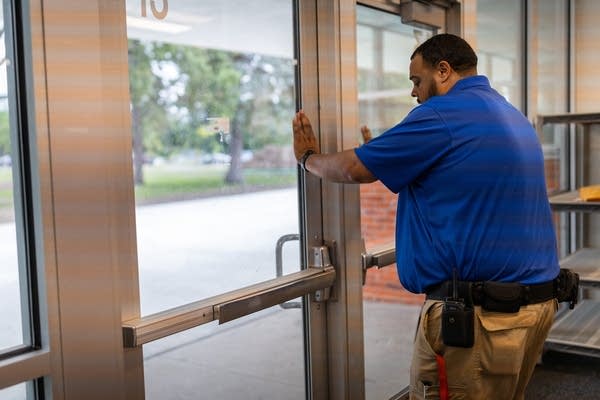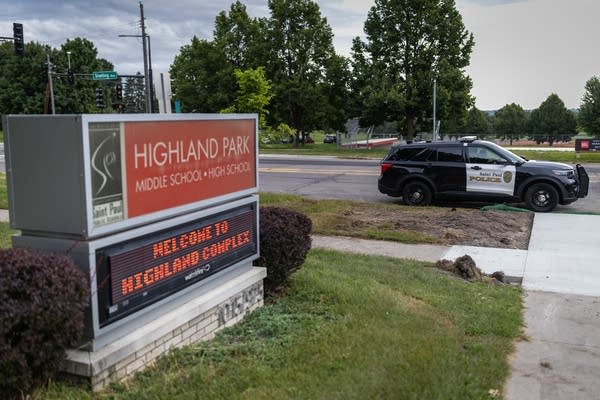ARTICLE AD BOX
A student at Johnson Senior High School in St. Paul was arrested on Tuesday after bringing a gun to school. No one was injured.
Shortly after the start of classes, an assistant principal, interventionist and school support liaison conducted a weapons search on a boy in the school, after receiving a tip. They found the gun and confiscated it. Officers from the St. Paul Police Department responded to a 9:30 a.m. call from the school, arrived shortly afterward and made the arrest.
“I understand this news can be extremely upsetting, especially on the first day of school. At the same time, I want to call out that our safety protocols worked as intended,” Johnson principal Jamil Payton wrote in an email to families late Tuesday.
Other students in the high school building were put into a “secure response.” They cleared hallways, turned off lights and waited in locked rooms on Tuesday morning while staff disarmed the student in question and contacted law enforcement.
District leaders declined to provide any details about who gave school staff the tip about the gun, saying it risked identifying sensitive information concerning who was involved in the incident.
St. Paul police said Tuesday there was “no ongoing threat related to this incident” and that they were continuing to investigate.
The St. Paul school district, which is the second largest in Minnesota, has spent years designing an approach to preventing violence in its student body that researchers say is focused on safety instead of “punishment” of students.
Five years ago school board members voted to do away with the district’s school resource officers. Instead they rely on a team of 35 school support liaisons who are trained in de-escalation and emergency protocols.
Laurie Olson, the district’s director of security and emergency management said even though they can handle bigger emergencies, the school support liaisons spend most of their time “speaking with kids, learning about kids.”
On Tuesday morning at Highland Park Middle School where MPR News reporters covered the first day of school activities, Michael Jett dressed in a neon vest stood outside the building directing traffic.

A school support liaison, Jett spent the previous week in training to “brush up on our policies and procedures ... just making sure we’re sharp and up-to-par for the school year.” But on Tuesday his work was focused on making sure kids coming to their first day of classes felt welcome.
“I’m big on relationship building, so I’m sure I’ll meet quite a few new kids,” Jett said. “I want them to see me not as a security guard but as a normal, common face that they can come up to with any question.”
Shortly after that conversation, one of Jett’s colleagues in a different SPPS building responded to a weapons tip and safely disarmed the student who’d brought a gun to Johnson High School.
“We followed our district protocols when the report was made. Administration and our on-site security staff quickly responded and followed our safety procedures,” Johnson principal Payton said.
That sort of flexibility, communication and responsiveness is what experts say is one of the keys to a system that works to keep kids safe.
Experts say students often are aware of other kids’ plans to use weapons or hurt others, and need to know they can trust adults with that information.
Jillian Peterson and James Densley have spent the past several years helping St. Paul design a comprehensive approach to school safety, drawing on funding from a federal grant. The two co-founded the Violence Prevention Project.

The district already has a tip line for students, staff and community members to report concerns, and in his letter to families Tuesday, Johnson principal Payton added a reminder about the need to communicate concerns to staff.
“Students are often aware of situations before adults, so please remind your child that it is important for them to immediately report concerns to a trusted adult,” Payton wrote. “This helps us take quick action to ensure the safety of all students and staff.”
St. Paul’s security work goes beyond trained liaisons and tip lines. Densley and Peterson have also helped launch multi-disciplinary teams that meet weekly to discuss student behavior issues and concerns as well as upcoming events that might need extra security planning.
“I think the key message, particularly in the context of the shooting [at Annunciation Church and School] in Minneapolis … is that we are all part of the solution, and we have to all be on that same page for this,” Densley said.






 English (US) ·
English (US) ·